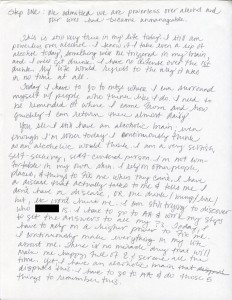Book: In Heaven Everything Is Fine: The Unsolved Life of Peter Ivers and the Lost History of New Wave Theatre
Authors: Josh Frank with Charlie Buckholtz
Type of Book: Non-fiction, biography, true crime
Why Do I Consider This Book Odd: Because it made me feel sorry for Chevy Chase for like a minute or so.
Availability: Published by Soft Skull in 2010, you can get a copy here:
Comments: I bought this book in my typical accumulator manner. I was at the annual New Year’s Day sale at BookPeople and the title caught my eye because like all slightly weird girls in the ’80s I was way into Eraserhead. It took me a couple of years to get around to reading it and I should have read it the moment I brought it home because this is a very readable and entertaining biography-true crime hybrid. The prologue of this book is one of the funniest things I have ever read. Ten pages of utter mayhem that should have humbled Chevy Chase forever. The prologue is the price of admission for this book, the reason you should read it, but after those hilarious, raucous ten pages, the rest of the book is deeply engrossing.
I had never heard of Peter Ivers before this book, which means I also had not heard of New Wave Theatre. He was a man who needed a book to help people like me know who he was and why he was so important and influential, even though his name is not remembered to the degree that his influence should dictate. The book as a whole is a look at how the Ivy League drama departments and National Lampoon magazine spawned Saturday Night Live, a whole bunch of hilarious 70s films like Caddyshack, and how Peter Ivers was a member of all those specific tribes as well as being a pioneer who introduced punk and new wave music to America on an early cable station.
Peter Ivers was one of those people who was perpetually ahead of the curve, able to know instinctively what was going to be the next big thing. Educated at Harvard, Ivers was primarily a musician and a song writer but his influence spilled over into much of the entertainment industry. Yet despite having his finger on many pulses, he never really achieved the level of fame his talent and perspicacity deserved. Worse, he was murdered right when it looked like he was about to become as famous as the people in his circles, like Harold Ramis, John Belushi, and Chevy Chase. His is a very sad story in so many ways, but at the same time the overwhelming sadness wasn’t apparent to me until I began to write this discussion because this book really is such an engaging, rollicking read that the sheer entertainment value of the book blunted the injustice of Ivers’ murder. That’s not a flaw, either, because eventually the reality of the waste of life hits you, but it’s also a testament to the interesting nature of Ivers’ life and the interesting nature of those around him that this is not a wholly sad book.
It’s actually maddening to realize what an interesting person Ivers was and know that he slipped under my radar for all these years, and the reason he was not even a blip on the mainstream radar is because he was indeed so far ahead of the curve that the public didn’t appreciate his efforts until the moment was gone. Muddy Waters once said that Ivers, who never missed a chance to jump up on stage and jam with blues men of great renown, was the best blues harmonica player alive, but Ivers’ band’s new wave album was released and received with little fanfare. However, David Lynch heard Ivers’ album and decided that Ivers’ sound was just what he needed for his bizarre film school effort, Eraserhead.
Typical of Ivers career, being recognized by Lynch and working with the filmmaker didn’t really do much for Ivers’ career, even though Ivers was responsible for one of the most iconic scenes and songs in film history – the mumps-cheeked girl in the radiator singing “In Heaven Everything Is Fine.”
That creepy voice? That’s Ivers. How the hell did I not know this all these years?
Well, I didn’t know it because Ivers’ influence and talent were often a part of someone else’s dream and goal.
Ivers seems to be best known for his work on New Wave Theater, an early live performance cable show with a format that introduced the public to a number of LA new wave and punk bands and popular comedians. Peter, the host, played the provocative, Harvard Boy weirdo to many rough-edged bands. Ivers was a tiny man but never failed in his role, often angering bands, sometimes being threatened by them as he interviewed them. That he often assumed a slightly homosexual persona only caused some of the more macho bands to channel their sense of unease into potential violence. However, many bands caught onto what was happening, understood the purpose of Ivers’ veiled jabs and sparkly appearance, and became friends with him, notably members from bands Fear, 45 Grave and The Dead Kennedys.
After a couple of years of hosting New Wave Theater, Ivers began to chafe under the pressure put on him by show producer David Jove, a drug-addled madman who surrounded himself with even madder madmen. Ivers had found a song-writing partner and together they were creating excellent songs that were selling well, and was poised to take his career in a new direction. Diana Ross and the Pointer Sisters ended up performing songs he and his partner wrote. With a blossoming career as a songwriter ahead of him, he eventually gave Jove notice on New Wave Theater. Shortly after giving notice, Ivers was found in his apartment, bludgeoned to death with a hammer.
The way the police handled the case will leave incredulous anyone with the most basic understanding of crime scene containment and murder investigation. Before the investigation even began, while the bloody sheets were still on the bed where Ivers died, people were permitted to come into Ivers apartment and rifle through his belongings, take out items, bring in new items and ultimately the police felt that Ivers was just some freak who likely got picked off by one of the punks he hung around with. The influence of the famous people advocating for Ivers – an ex-girlfriend who was a studio executive and Harold Ramis among them – wasn’t enough to overcome the horrible way the police handled the investigation. He was killed in 1983 and the most-likely suspect has died of cancer, so there will never be much in the way of justice for Ivers, outside of this book that shows us all how important Ivers was and how was he the sort of guy who anticipated MTV several years in advance, who understood the importance of David Lynch before anyone else, who could walk the talk amongst Harvard graduates, street punks, Hollywood executives, pop stars, blues men, and the cinema avant garde.
The book details all the relationships Ivers had with rich and powerful people, as well as giving the reader a look at his personal and romantic relationships. The former are pretty interesting, the latter less so (I found his long-term girlfriend so insufferable that I found myself glossing over all passages involving her – she was the sort of woman who considered herself counter-cultural, accepted a job with a major studio in defiance of her personal beliefs, then spent weeks crying about it – bleah), but even the less interesting passages don’t really diminish what an interesting person Ivers was and how interesting this book is. I sailed through it in two readings. Seldom do biographies or true crime books demand my attention this way.
The best line in the book:
To Peter, underutilized potential was a tear in the fabric of the cosmos.
The hell of it is, Peter’s potential was never underutilized. Plenty of people utilized it. He just didn’t receive much benefit from all that utilization.
This is one of my shorter reviews because the scope of this book is such that one either goes on at length and still barely scratches the surface or one mentions the best parts and still barely scratches the surface. For once I decided to err on the side of word conservation.
But I cannot emphasize enough how very funny, actually hilarious, the prologue is. Seriously, I read it out loud to Mr Oddbooks and we both laughed until we could not breathe. Chevy Chase, in a mohawk wig, trying to host a New Wave Theater-successor while shit-faced drunk, completely unfamiliar with punk culture, screaming at bewildered punks, “IS THERE ANYONE ELSE WHO THINKS THEY CAN TAKE ME DOWN?!” while Cyndi Lauper waits in the wings, presumably wondering if she should fire her manager. Highly recommended.


